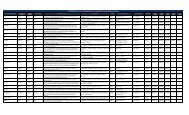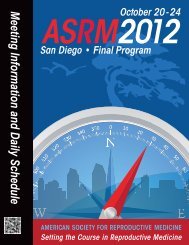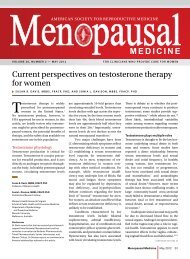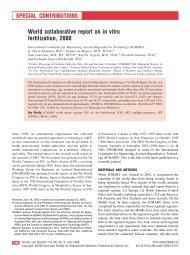scientific program • symposia - American Society for Reproductive ...
scientific program • symposia - American Society for Reproductive ...
scientific program • symposia - American Society for Reproductive ...
You also want an ePaper? Increase the reach of your titles
YUMPU automatically turns print PDFs into web optimized ePapers that Google loves.
seconds and time-lapse digital recordings are analyzed<br />
<strong>for</strong> phenotypic abnormalities. Representative findings from<br />
seventy tri-pronuclear embryos are displayed in this video,<br />
along with an explanation <strong>for</strong> observed events.<br />
MATERIALS AND METHODS: TLM is a powerful tool to analyze<br />
early embryo development. Analysis of TLM images<br />
recorded from tri-pronuclear embryos provides important<br />
insight into the mechanisms of early mitotic and other<br />
developmental events.<br />
__________________________________________________________<br />
V-4 11:52 AM<br />
RESCUE OF AGED OOCYTES USING TRANSFER METAPHASE -II<br />
NUCLEAR TRANSFER.<br />
A. Tanaka1, M. Nagayoshi1, I. Tanaka1, H. Kusunoki2, S.<br />
Watanabe3. 1Saint Mother Hospital, Kitakyushu, Fukuoka,<br />
Japan; 2Faunal Diversity Sciences Graduate School<br />
of Agriculture, Kobe University, Kobe, Hyogo, Japan;<br />
3Department of Anatomical Science, Hirosaki University<br />
Graduate School of Medicine, Hirosaki, Aomori, Japan.<br />
OBJECTIVE: Nuclear transfer into the metaphase-II(M-II)<br />
oocytes shows promise as a means of repairing female<br />
infertility due to ooplasmic deficiency and abnormalities.<br />
We there<strong>for</strong>e conducted nuclear transfer of in vitro matured<br />
metaphase-II oocytes (recipient oocytes) into enucleated<br />
freshly ovulated metaphase-II oocytes (donor oocytes).<br />
DESIGN: Recipient and donor oocytes were placed in<br />
a microdrop containing 5 μ/ml of cytochalasinB (CCB).<br />
The aspirated M-II karyoplast of the recipient oocyte was<br />
transferred into the perivitelline space of an enucleated<br />
donor oocyte. The grafted oocyte was transferred in a 295<br />
μm mannitol solution containing 0.05 μm MgCl2. Membrane<br />
fusion was facilitated by electrical stimulation (5V <strong>for</strong> 1<br />
second AC + 15V <strong>for</strong> 33 microseconds DC) with an electro<br />
cell fusion generator (LF 201). After fusion, the constructed<br />
oocytes were cultured in HTF medium <strong>for</strong> 2 hours and ICSI<br />
was per<strong>for</strong>med.<br />
The percentage of identification of M-II chromosome was<br />
90.1 % (82 out of 91) in freshly ovulated oocytes and 96.0%<br />
(48 out of 50) in vitro-matured oocytes.<br />
The M-II karyoplast was removed successfully in 72 of 82<br />
(87.8%) of the donor oocytes and 81 of 95 (85.2%) of the<br />
recipient oocytes. All of 81 karyoplasts of recipient oocytes<br />
were replaced in the periviteleine space of enucleated<br />
donor oocytes and 64 of these 79.0% were fused to <strong>for</strong>m a<br />
reconstituted oocyte.The fertilization rate, cleavage rate<br />
and blastocyst <strong>for</strong>mation rate following ICSI <strong>for</strong> constructed<br />
oocytes and recipients oocytes were(68.8%(44/64),<br />
64.1%(41/64), 25.0%(16/64)),(59.0%(58/98), 26.1%(25/98),<br />
3.4%(3/98))respectively. Chromosomal analysis of 6 embryos<br />
following nuclear transfer indicated they were all diploid sets<br />
of 46 chromosomes.<br />
MATERIALS AND METHODS: These results demonstrate that<br />
this technique can be applied to the treatment of female<br />
infertility due to ooplasmic deficiency and abnormalities in<br />
aged oocytes.<br />
__________________________________________________________<br />
V-5 12:00 PM<br />
SUCCESSFUL HUMAN SPERMATID INJECTION INTO OOCYTES.<br />
A. Tanaka, M. Nagayoshi, I. Tanaka. Saint Mother Hospital,<br />
Kitakyushu, Fukuoka, Japan.<br />
OBJECTIVE: In cases where the patient’s most developed<br />
spermatogenic cell is a spermatid, the spermatid injection<br />
into the oocyte is the sole treatment available to conceive.<br />
However the success rate is very low. From this low success<br />
VIDEO PROGRAM<br />
96<br />
rate we can infer that the oocyte activating substance in<br />
spermatids might be less sufficient than that of in matured<br />
spermatozoa. Electrical stimulation of oocytes revealed the<br />
beneficial effects on oocyte activation and subsequent<br />
embryonic development. We here explain the procedure of<br />
spermatid injections into electrically activated oocytes.<br />
DESIGN: This study deals with non-obstructive azoospermic<br />
men whose spermatogenesis was arrested at the level of<br />
early spermatid (Sa,Sb) or late spermatid (Sc, Sd) (Clermont<br />
1963) or whose testicular spermatozoa were completely<br />
abnormal in shape. Biopsied testicular tissues were in D-PBS<br />
containing 0.125% collagenase and 0.01% DNase. Oocytes<br />
were transferred to 295mM solution of mannitol with 0.1mM<br />
CaCl2 and 0.05mM Mgcl2 and exposed to an alternating<br />
current of 8V / cm 1000KHz <strong>for</strong> 8s, followed by a single<br />
1200V / cm pulse of direct current <strong>for</strong> 99μs. Each spermatid,<br />
transferred into PVP-HTF, was drawn into an injection pipette<br />
(7 μm I.D. <strong>for</strong> Sa or Sb, 5 μm I.D. <strong>for</strong> Sc, 3μm I.D. <strong>for</strong> Sd) and<br />
the separated nucleus and cytoplasm were injected into<br />
the ooplasm. Injected oocytes were cultured in sequential<br />
media and their embryonic development was observed<br />
until the blastocyst stage.<br />
MATERIALS AND METHODS: Fertilization rate, cleavage rate<br />
and blastocyst rate following spermatid injection with<br />
or without electrical stimulation were [ 63.8%(162/254),<br />
72.2%(117/162), 16.7%(27/162)] and [30.0%(93/310),<br />
70.8%(34/48), 8.3%(4/48)] respectively. Pregnancy rate and<br />
miscarriage rate between two different stage of spermatids<br />
(early : Stage a-b, late: stage c-d) were [14.0%(310/2214),<br />
46.6%(48/103)], [20.0%(414/2073), 29.0%(120/414)]. The<br />
spermatid injection into the electrically activated oocytes<br />
was revealed to be useful in clinical application.<br />
__________________________________________________________<br />
V-6 12:07 PM<br />
CRYOPRESERVATION OF OVARIAN TISSUE BY VITRIFICATION.<br />
S. J. Silber1, N. Kagawa2, K. Lenahan1, J. Hicks1, M.<br />
DeRosa1, M. Kuwayama3. 1Infertility Center of St. Louis, St.<br />
Luke’s Hospital, St. Louis, MO; 2Kato Ladies Clinic, Tokyo,<br />
Shinjuku, Japan; 3Repro Support Medical Research Centre,<br />
Tokyo, Shinjuku, Japan.<br />
OBJECTIVE: To virtually eliminate oocyte loss from the<br />
freezing technique using a vitrification protocol instead of<br />
classic slow freeze methods.<br />
DESIGN: Virtually all of the primordial follicles of the ovary are<br />
in the thin fibrous cortex within one millimeter of the surface.<br />
This has allowed the freezing, thawing, and transplantation<br />
of ovarian tissue slices resulting in live healthy offspring in<br />
both humans and experimental animals. However, the<br />
procedure resulted in substantial egg loss from both the<br />
transplantation technique and from the freezing process<br />
itself. Ischemic loss of eggs from the transplant technique<br />
can be reduced greatly by using very thin slices and by<br />
avoiding micro-hematoma <strong>for</strong>mation underneath the<br />
graft, exactly like with skin grafts in plastic surgery. In this<br />
video, we interview a typical such cancer patient and<br />
then demonstrate the technique <strong>for</strong> both vitrification and<br />
thawing of ovarian tissue. Then with a different patient we<br />
demonstrate the surgical technique which minimizes oocyte<br />
loss from ischemia as well.<br />
MATERIALS AND METHODS: Histology and vital staining fail<br />
to reveal any difference between fresh ovarian tissue and<br />
tissue cryopreserved by vitrification.<br />
__________________________________________________________








